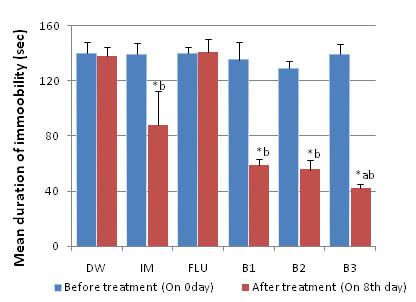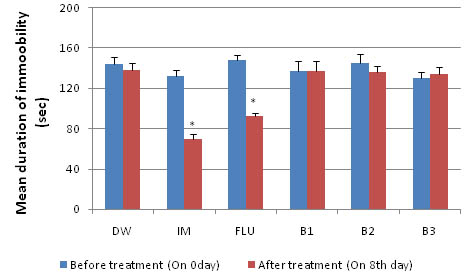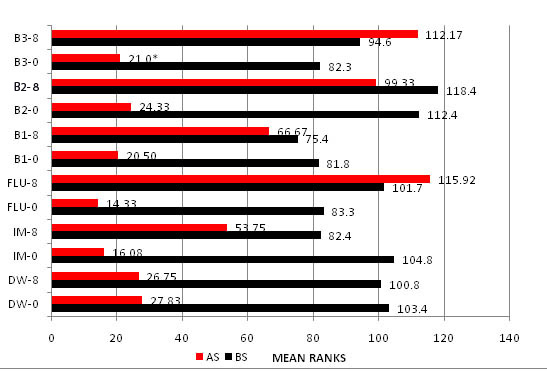Depression is one of the most common psychiatric disorders. According to WHO, depression is expected to become the second leading cause of disease related disability by the year 2020, following heart disease [1].
Currently available treatment of depression is often associated with several undesirable side effects and it is effective only in a certain portion of the patients [2]. A search for novel pharmacotherapy from medicinal plants for psychiatric illnesses has progressed significantly in the past decade. A large number of herbal preparations for antidepressant activity have been evaluated in a variety of animal models [3]. From ancient time different herbal preparations like brahmi, withenia somnifera, and rauwolfia serpentina have been used to treat psychiatric disorders. These herbal drugs are used successfully for long time because of easy availability and cost effectiveness. Literatures are meager and scientific validation are lacking.
Brahmi is a small perineal creeping herb of scrophulariaceae family. It has small oblong leaves and light purple flowers. It grows in wet and sandy area. It is a herb, flowers and fruits appear in summer. The whole plant is used in traditional medicine. Brahmi is the Sanskrit name for the herb bacopa monniera. Brahmi has been used in ayurvedic medicine, since centuries [4,5]. The plant extracts has been used for enhancing memory and improving functions of brain [6,7], Cognitive enhancer [8,9] antioxidant [10,11], antiulcerogenic agent [12], anti-inflammatory, anxiolytic [13]. Studies have reported antidepressant activities of brahmi [14–16]. This study is to assess the antidepressant activity of brahmi 10mg/kg, 20mg/kg, 30mg/kg in different experimental models like FST, TST and SID .
Materials and Methods
One hundred and eight swiss albino mice (25-35 gms body weight) of either sex were randomly selected and grouped into 18 groups (n=6). They were acclimatized and housed in animal house with 12hr: 12hr light-dark cycle at 27±2°c temperature and 45-55% relative humidity. Food and water supplied ad libitum. The work was approved by the Institutional Animal Ethical Committee (IAEC). Control animals were treated with distilled water. Drugs like imipramine (10mg/kg), fluoxetine (30 mg/kg), test drug brahmi (10 mg, 20mg, 30mg/kg) were dissolved in distilled water and administered orally once daily for seven days. On 8th day tests were repeated [Table/Fig-1].
| Drugs & Doses (mg/kg) | Experimental Models |
|---|
| FST | TST | SID |
|---|
| Distil water (0.5ml/animal) | Group 1 | Group 7 | Group 13 |
| Imipramine (10mg/kg) | Group 2 | Group 8 | Group 14 |
| Fluoxetine (30mg/kg) | Group 3 | Group 9 | Group 15 |
| Brahmi (10mg/kg) | Group 4 | Group 10 | Group 16 |
| Brahmi (20mg/kg) | Group 5 | Group 11 | Group 17 |
| Brahmi (30mg/kg) | Group 6 | Group 12 | Group 18 |
Forced swimming test
Mice were forced to swim individually for 15 min, in a glass beaker of 11cm diameter, 15cm height containing fresh water up to a height of 6cm, at a temperature of 27±2oc. This constituted the “pre-test” session. Twenty four hours later each mouse was once again forced to swim in a similar environment for a period of 6 min in a “test-session” [17,18]. The test-session was conducted before (0 day) and after the drug treatment (on 8th day). The mouse was considered immobile when it floats motionlessly or made only those movements necessary to keep its head above the water surface [19]. The total duration of the immobility during the last 4 min of the 6 min test was recorded.
Tail suspension test
Mice were suspended by tail from a height of 75cm [19]. The mouse made attempts to regain upright posture, but continued in a motion less state [20,21] (immobility phase). Baseline immobility was measured for a period of 6 min. After that, drugs were administered to the mice for 7 days. On the 8th day the duration of immobility was recorded for a period of 6min.
Shock induced depression
Mice were Shocked for 1 hour (0.75mA, 5sec duration at an interval of 10sec) on a metal grid floor [22]. Activity was recorded in actophotometer for a period of 10min before and after shock on 0 day and 8th day.
Statistical Analysis
The continuous data were analyzed by ANOVA followed by “post ANOVA t-test” (LSD). Discrete data were analyzed by Kruskal Wallis test to find out difference in the activity of SID. p-value ≤ 0.05 was accepted as level of significance (5%).
Results
Effect of drugs on forced swimming test
Distilled water and Fluoxetine (30mg/kg) did not show any significant reduction in duration of immobility (p > 0.05). Imipramine (10mg/kg), brahmi in 10, 20 & 30mg/kg significantly (p<0.05) reduced the duration of immobility by 36.87%,56.33%, 56.96% and 69.86% respectively [Table/Fig-2].
Effect of drugs on FST in albino mice. DW = Distilled water = Imipramine 10mg/kg = Fluoxetine 30mg/kg, B1= Brahmi 10mg/kg, B2= Brahmi 20mg/kg, B3= Brahmi 30mg/ Kg. Values are expressed as Mean±SEM, n=6, *=> p < 0.05 when compare to the distilled water, a=> p < 0.05 when compared with imipramine, b=> p < 0.05 when compared with fluoxetine

Effect of drugs on tail suspension test
Distilled water did not show any significant reduction in duration of immobility (p > 0.05). Imipramine (10mg/kg) and fluoxetine (30mg/kg) significantly (p < 0.05) reduced the duration of immobility by 47.67%, 37.43% respectively. Brahmi did not show any significant (p > 0.05) reduction in duration of immobility in this model [Table/Fig-3].
Effect of drugs on TST in albino mice. DW = Distilled water = Imipramine 10mg/kg = Fluoxetine 30mg/kg, B1= Brahmi 10mg/ Kg, B2= Brahmi 20mg/ Kg, B3= Brahmi 30mg/ Kg. Values are expressed as Mean±SEM, n=6, *p < 0.05 when compare to the distilled water.

Effect of drugs on shock induced depression
Shock reduced the activity of animal, it was measured in actophotometer. Treatment with drugs for 7 days decreased reduction of shock induced decrease in activity. Distilled water treatment did not exhibit any change in activity. The standard drugs imipramine, fluoxetine and the test drug brahmi 10, 20, 30mg/kg had restricted the shock induced reduction in activity. But brahmi in higher dose 30mg/kg totally abolished the reduction in activity [Table/Fig-4]. This observation indicates antidepressant activity of brahmi in the SID model, is more effective.
Effect of drugs on SID in albino mice. DW = Distilled water= Imipramine 10mg/ Kg, = Fluoxetine 30mg/ Kg, B1= Brahmi 10mg/ Kg, B2= Brahmi 20mg/ Kg, B3= Brahmi 30mg/ Kg, 0= 0day, 8=8th day, AS= after shock, BS= before shock

Discussion
This study was conducted to assess the antidepressant activity of brahmi in albino mice in FST, TST and SID were used for this study. Exposure to stress plays an important role in depression [23]. These animal models produce physical stress and lead to depression. TST, FST models of depression which provides a rapid and reliable behavior screening test for antidepressants. The immobility has been expected to reflect a state of behavioral despair and failure to adapt to the stress [22]. Antidepressant drugs decrease immobility time in both FST and TST [24].
To date numerous animal models of depression have been designed either as empirical tests that attempt to screen potential antidepressants or as models that try to explain the theoretical basis of depression. No single model is complete, but a model may be valid for certain types of depression. A battery of animal models, standard drugs for the study have to be considered to evaluate the therapeutic efficacy of a test drug. Several studies indicate that serotonin uptake inhibitors, serotonin agonists or 5-hydroxytryptophan 5-HTP) are ineffective in FST test [25,26]. The SID model is more effective in behavioral despair leading to depression. The SID model with the FST and the TST, can serve as a more efficient model of depression [25].
Imipramine acts by inhibiting NE reuptake and has been used as a standard drug in majority studies. The beneficial effect of imipramine in the FST model seems to be due to increased availability of these neurotransmitters nor epinephrine (NE) and serotonin (5HT) at the post synaptic site following reuptake inhibition [25]. Fluoxetine is selected as second standard drug because it acts by selectively inhibiting reuptake of serotonin. Brahmi contains a natural phytonutrients which is known as bacosides. This is responsible for improving vital neurotransmitters activities which happen in memorization and information process and may be helpful in depression [24].
Effect of drug on forced swim test
The FST model is the more widely used animal model for screening antidepressant acitivity [27]. Fluoxetine did not show any significant effect [23,24]. Imipramine (10mg/kg), brahmi (10, 20, 30mg/kg) significantly decreases the duration of immobility by 36.87%, 56.33%, 56.96% and 69.86% respectively. Activity of brahmi, in the doses studied is identical to that of imipramine. The observations are supported by the studies of Sairam K et al.,[15], Yun-Heng Shen et al., [16] and Chatterjee et al., [24].
Effect of drugs on tail suspension test
Imipramine (10mg/kg), fluoxetine (30mg/kg) significantly decreases the duration of immobility by 47.67%, 37.43% respectively. But brahmi did not produce any effect in the doses studied (10, 20 & 30 mg/kg ). However Manavi Chatterjee et al., [24] used higher doses like 40,80,160 mg/kg has shown significant effect in TST model.
Effect of drugs on shock induced depression
Shock has significantly decreased the activity in photoactometer, suggesting shock has produced depression. Imipramine (10mg/kg), fluoxetine (30mg/kg), brahmi (10,20,30mg/kg) had significantly retain the activity by 77%, 99.5%, 93.4%, 95%, 133.3% respectively indicates the antidepressant activity in SID.
Conclusion
Three different doses of brahmi exhibited antidepressant activity in mice in FST and SID models. It failed to demonstrate antidepressant activity in the TST model.